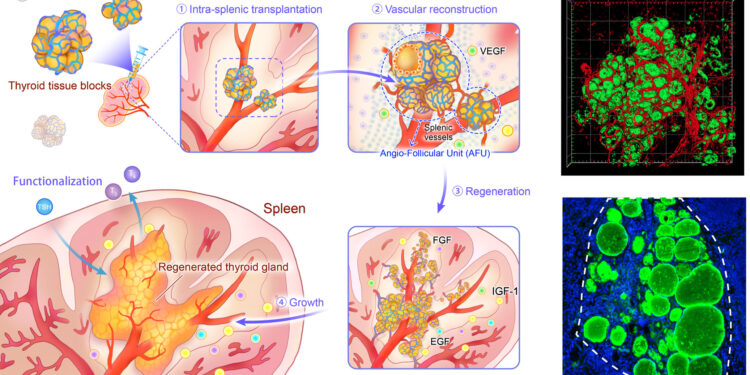Schematic description of intra-splenic thyroid regeneration (left) and staining images of reconstructed thyroid tissues in the spleen (right). Credit: Lei Dong
Patients undergoing total thyroidectomy generally require lifelong oral treatment with levothyroxine sodium (L-T4). Although effective in maintaining baseline serum hormone levels, this treatment fails to restore the dynamic and responsive regulatory capacity of triiodothyronine (T3), essential for critical physiological regulatory functions. Clinical evidence indicates that T3 deficiency may increase the risk of hypertension, cardiac dysfunction, and other metabolic or mental health problems.
Regenerative medicine involves the use of tissue engineering to create cell and tissue transplants, potentially replacing the need for hormone replacement therapy. However, previous experiments with thyroid autotransplantation in animals and humans, targeting muscular or subcutaneous sites, have yielded unsatisfactory results. The effectiveness of tissue or cell regeneration depends on various factors, including the condition of the transplanted tissue, site and method of transplantation.
In a recent study in Advanced science, Dong’s research team proposed an innovative solution to the challenges of transplantation by growing the thyroid in the spleen. By taking advantage of the unique properties of the spleen, characterized by a loose structure and rich blood supply, the team explored a new strategy for thyroid regeneration. Intrasplenic thyroid transplantation was performed without compromising the structure and function of the spleen.
Mice that had undergone total thyroidectomy received a transplant of thyroid glands into the spleen, with intact follicles and reconstructed vascular networks. This approach successfully recapitulated the angiofollicular unit (AFU), leading to the complete restoration of hormone levels in mice.
Additionally, studies have demonstrated that this method is more effective in responding to physiological signals than hormone replacement therapy. Furthermore, long-term evaluation of the effects of hormone replacement therapy proved that regenerated thyroid glands in the spleen completely restored physiological homeostasis in mice after total thyroidectomy without any adverse side effects, indicating significant potential for clinical applications.

Serum hormone levels in hypothyroid mice fully recovered within 4 weeks after intrasplenic thyroid transplantation and remained stable for 16 weeks thereafter. Hormone levels in these ST mice decreased immediately after splenectomy of the spleen containing the thyroid gland. Credit: Lei Dong
Regeneration of complex organs constitutes the most important challenge in the field of regenerative medicine. The main obstacle to progress in this area arises from the lack of effective methods to regenerate a fully developed large-scale circulatory system in the body of adult animals.
This circulatory system is essential to support the regeneration of targeted organs. To address this challenge, Professor Dong Lei and his collaborators recently proposed an innovative approach.
They exploit the unique structural features of the spleen, such as its abundant blood supply, loose internal structure, and ability to accommodate significant numbers of implanted cells and tissues, as a regenerative platform for ectopic organ regeneration complex tissues in the body.
Over the past few years, they have developed a series of technical approaches to modify the structure of the spleen in living animals, aligning it with the regenerative requirements of the target tissues and organs. The notable achievements of their previous research involve the successful regeneration of the liver in the spleen.
The concept of regenerating one organ within another introduces the prospect of forging a new technological pathway to regenerate large and complex organs, distinct from conventional methods. This innovative approach has the potential to lead to significant breakthroughs in the field of regenerative medicine.
More information:
Xue‐Jiao Tian et al, Regeneration of thyroid glands in the spleen restores homeostasis in thyroidectomy mice, Advanced science (2023). DOI: 10.1002/advs.202305913
Provided by Nanjing University School of Life Sciences
Quote: Mouse study successfully regenerates spleen’s thyroid glands (December 12, 2023) retrieved December 12, 2023 from
This document is subject to copyright. Apart from fair use for private study or research purposes, no part may be reproduced without written permission. The content is provided for information only.



